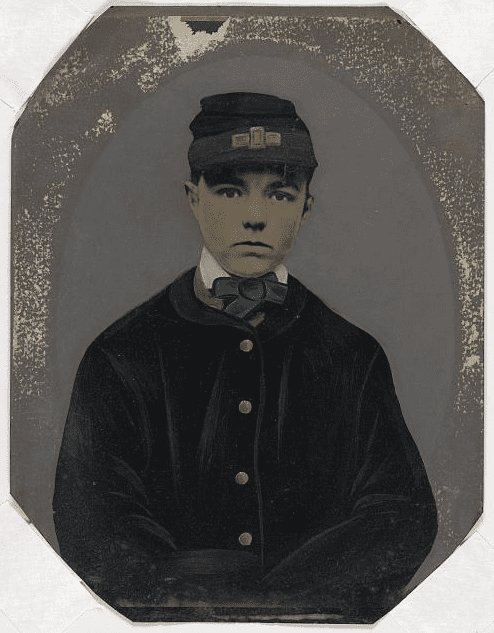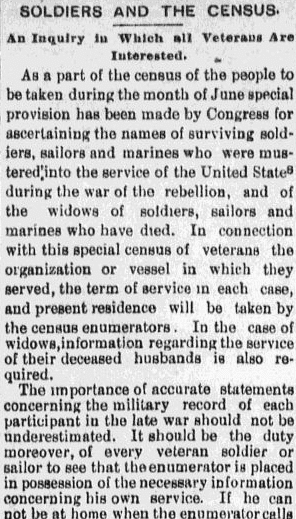Introduction: In this article – part of an ongoing “Introduction to Genealogy” series – Gena Philibert-Ortega describes how not all of the 1890 census information was destroyed in the 1921 Commerce Building fire – many records from the 1890 Veterans Schedule still survive. Gena is a genealogist and author of the book “From the Family Kitchen.”
The initial reaction most family history researchers have when they hear the words “1890 census” is sadness, due to its almost complete destruction in the 1921 Commerce Building fire. But there were more records from that census year than just the doomed population schedule – other schedules (records) still survive. For example, for those with Union veterans or their widows in their family tree, there may still be hope of learning more about your ancestors, thanks to the 1890 Veterans Schedule. While not all of this enumeration survives (more on that below), this schedule offers another place to learn more about a Union veteran ancestor.

The 1890 Veterans Schedule
According to the United States Census Bureau, the 1890 Veterans Schedule was conducted at the request of the U.S. Pension Office to “help Union veterans locate comrades to testify in pension claims and to determine the number of survivors and widows for pension legislation.” In addition, some congressmen were also interested in this enumeration to learn more about the correlation between military service and longevity.*

The fact that this schedule was to be used by citizens to find long-lost comrades is very different than the goal of any other census enumeration. Its plan for immediate access for the public is contrary to how we are accustomed to accessing the census; normally, information is only available after a 72-year privacy period. Yes, individuals can write to the Census Bureau to obtain information from a schedule where they themselves appear in order to obtain age verification, but in the case of the Veterans Schedule the intent was that the census information would be published, then distributed to “…libraries and veterans’ organizations so individuals could more easily locate their fellow veterans.”**
Unfortunately, this never happened.
Information found in the “Special Schedule – Surviving Soldiers, Sailors, and Marines, and Widows, etc.” documents the name, rank, company, name of regiment or vessel, date of enlistment, date of discharge, length of service, post office address, disability incurred, and any additional remarks including details about wounds sustained, where the person was held a prisoner of war, and more. In cases where the veteran was deceased, his information and the name of his widow was included. While this schedule was to collect information about only Union veterans, there are some instances where non-Union and non-Civil War soldiers were enumerated.
Initially, 1,099,668 Union survivors and 163,176 widows were counted. However, additional efforts to find every veteran or widow continued via newspaper articles and through correspondence.*** Unfortunately, due to a lack of funding and government red tape, the initial intentions for this census were never carried out.
Availability Today
While it appears these schedules could not have been affected by the 1921 Commerce Building fire that destroyed the 1890 population schedules, the Veterans Schedule is not wholly intact. Some of the enumeration was destroyed prior to its transfer to the National Archives in 1943.****
Unfortunately, there are a number of states missing from the schedules. States missing include Alabama through Kansas and half of Kentucky. However, there are a few places among the destroyed states that can be found at the end of the Washington D.C. and Miscellaneous microfilm roll, including: “California (Alcatrez); Connecticut (Fort Trumbull, Hartford County Hospital, and U.S. Naval Station); Delaware (Delaware State Hospital for the Insane); Florida (Fort Barrancas and St. Francis Barracks); Idaho (Boise Barracks and Fort Sherman); Illinois (Cook County and Henderson County); Indiana (Warrick County and White County); and Kansas (Barton County).”*****
The 1890 Veterans Schedule is available on National Archives and Records Administration microfilm. You can read more about the schedule on their 1890 Census web page.
You can search this schedule on the FamilySearch web page.
————————-
* “1890 Veterans Census,” United States Census Bureau (https://www.census.gov/history/www/genealogy/decennial_census_records/1890_veterans_census.html: accessed 9 June 2017).
** “First in the Path of the Firemen: The Fate of the 1890 Population Census, Part 2,” Prologue Magazine (https://www.archives.gov/publications/prologue/1996/spring/1890-census-2.html: accessed 9 June 2017).
*** Ibid.
**** “1890 Veterans Census,” United States Census Bureau (https://www.census.gov/history/www/genealogy/decennial_census_records/1890_veterans_census.html: accessed 9 June 2017).
***** “First in the Path of the Firemen: The Fate of the 1890 Population Census, Part 2,” Prologue Magazine (https://www.archives.gov/publications/prologue/1996/spring/1890-census-2.html: accessed 9 June 2017).
Related Articles:
